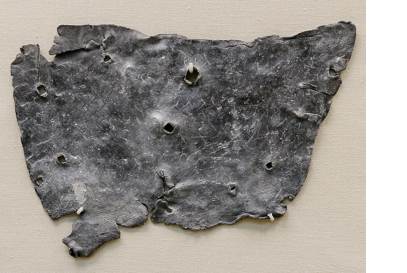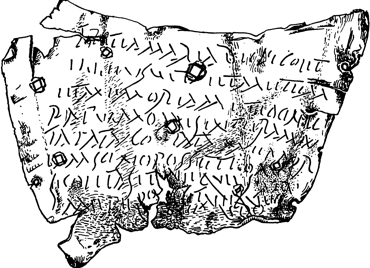Tretia Maria
Tretia Maria

The third case study of women and religion looks at a fragment of a curse tablet which is used to place a curse on a woman named Tretia Maria. It is made from lead and has writing scratched onto it in Latin.
It is dated to sometime during the Roman occupation of Britain between the 1st and 4th centuries AD but can’t be dated more closely than that.
It was found in Telegraph Street in Moorgate in London in 1934 and is now in the British Museum and is also on display in Gallery 49.
It is quite big measuring 220mm and it has been pierced with seven holes – and we’ll see why that’s relevant below.
Large number of curse tablets found in Roman Britain, with two important groups of these coming from Bath and a rural shrine at Uley in Gloucestershire. They seem to have been most popular in the second and third centuries CE.
Use of curse tablets
The purpose of curse tablets was to send messages from individuals to gods asking them to intervene on their behalf and to bring supernatural power to bear on individuals or sometimes groups of people, against their will.
Sometimes they asked for the god to intervene and to right a wrong the person had done – for example reinstate something that had been stolen. Their motives are usually negative, and they often seek revenge and are sometimes quite violent.
So why was lead the preferred material? It was low cost, and readily available as a by-product of the silver-mining and pewter industries. But perhaps one of the main reasons is that the use of lead meant that the tablets were easy to make. Hot lead was poured into a mould, smoothed, and cut into small individual tablets when cooled. After the curse had been inscribed on the tablet (one side only) it was rolled up or folded and this was to ensure that it was only legible to the god alone.
But the act of rolling and folding were also thought to help with the magical effectiveness of the curse. Nailing was a common feature as well and this is thought to have been to help bind or fix the person named in the curse.
Most commonly they were then put in places where the god addressed could read them, so temple sites and shrines, but also sometimes underground in or near graves, or bodies of water, or in sanctuaries to underworld deities, and sometimes they were even placed in people’s homes. This was also designed to help with the efficiency of the curse.
The great thing about curse tablets are that they give us some access to the real-life issues that people had – things being stolen and relationships with others. They also were written by a variety of people, so we get to hear the voices of provincial people and non-citizens, slaves and women.
The inscription
 Unfortunately, we only have part of the curse and not the whole thing, but it is translated as:
Unfortunately, we only have part of the curse and not the whole thing, but it is translated as:
“I curse Tretia Maria and her life and mind and memory and liver and lungs mixed up together, and her words, thoughts, and memory; thus may she be unable to speak what things are concealed, nor be able ... nor …”
We have no idea who Tretia Maria may have been, but there is some thought that her name may have been inscribed wrong and that it should have been Tertia which is a more common Roman name, but this doesn’t help us find out who she was.
Obviously, this is very personal and direct and wishes fairly ill-health on Tretia Maria and it makes you wonder what she may have done to deserve this!
You may want to look up other curse tablets online to see the variety of things they include.
